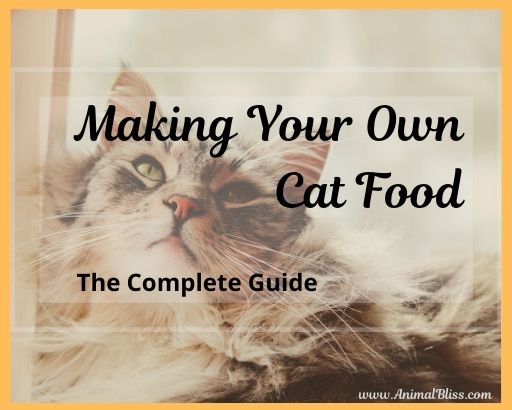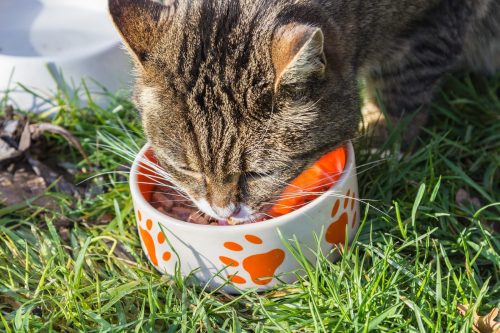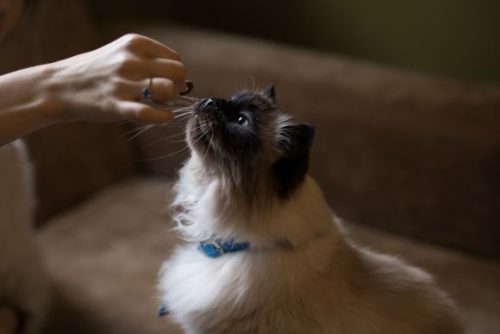Making Your Own Cat Food
Curious about making homemade cat food? Even though kibble is convenient and most cats enjoy their nibbles and canned food, there are a few reasons why you might want to consider making your own cat food. After all, our feline friends are predators, designed to eat a diet based on raw meat. If your cat is diabetic or has a chronic illness, your vet might recommend a raw diet, or they might advise you to give homemade cat food a try. Here, the team at We’re All About Cats give us some expert advice.

Important Precautions Before You Get Started
Quality pet food has been specially formulated to provide your cat with proper nutrition, and some vets warn against raw diets and homemade cat food for this reason.
We’ll be honest: making your own cat food can be time-consuming compared to just shopping for the best canned cat food, plus it’s vital to get the vitamin and mineral balance right. Additionally, freshness is key. Not only could bacterial contamination cause illness, but most cats won’t touch food that isn’t perfectly fresh. Be sure that you start with fresh ingredients, keep your equipment as clean as if you were prepping a recipe for yourself, and store your DIY cat food carefully.
Remember: Cats have special nutritional needs. They are obligate carnivores, meaning they cannot survive without protein and amino acids from meat and fish. Do not attempt to feed your cat a vegan diet.
Cats need a blend of vitamins, fatty acids, and minerals as well. Some cats with special medical needs might require a different blend of nutrients, and in cases like this, it’s best to consult with your vet concerning feeding. For example, cats with Chronic Kidney Disease (CKD) need a unique balance of magnesium, phosphorus, and other components that are best obtained in a specially formulated mix purchased from your veterinarian or another trusted source.
Is Homemade Cat Food Right for Your Pet?
To provide this guide to making your own cat food, we consulted several research papers from highly-regarded sources including the Journal of Feline Medicine and Surgery, BMC Veterinary Research, and British Journal of Nutrition. We also read personal accounts from people who make their own cat food, and we discussed the matter with feline nutrition experts. Here’s what we learned.
Some cats may do better on a diet consisting of homemade cat food simply because you control every ingredient that goes into your recipe. If your cat is allergic to chicken, for example, you can ensure that no chicken (one of the leading food allergens for cats) makes it into their diet. If your cat suffers from obesity (one in three cats is overweight) then a homemade diet for overweight cats might work wonders as commercial food is often laden with fillers including sugar and starches that simply amount to empty calories.

Types of Homemade Cat Food
There are three basic types of homemade cat food: raw, semi-cooked, and cooked. Raw homemade cat food requires less supplementation, but it does come with more concerns about bacteria. Luckily, basic cleanliness precautions, fresh ingredients, and sensible, safe storage should be enough to combat bacteria. After all, cats have been eating raw, dead animals for millennia, and their stomach acid is about 10 times stronger than ours.
Semi-cooked homemade cat food is briefly baked to kill surface bacteria and enhance safety. At the same time, this process destroys some nutrients.
According to wereallaboutpets.com, cooked homemade cat food reduces the risk of parasites, pathogenic bacteria, and other organisms that might cause illness in your cat (or you). It’s more challenging to get the nutrients right when you cook food for your cat.
Tools and Ingredients for Making Your Own Cat Food
Our furry feline friends might be docile and downright lazy at times, but don’t let that fool you. They’re almost genetically identical to African wildcats, and their natural diet of bugs, birds, rodents, and lizards is perfect for their needs. Luckily, the ingredients in homemade cat food are a little easier to obtain and work with. At the same time, you’ll need a few special tools to deal with those ingredients.
Meat Grinder
Since most cat food recipes call for meat with bones, it’s best to purchase a powerful meat grinder that can handle the task. If you have a powerful blender or food processor such as a Vitamix, it may be able to handle small bones.
If you like, you can use a bone substitute such as eggshell powder or bone powder, which can be mixed with meat and organs that you mince with a knife. Be careful not to add too much bone, however, since excess bone consumption can cause constipation or lead to over-mineralization, which can, in turn, cause urinary crystals. Read up on the best cat food for urinary health.

Kitchen Scale
DIY cat food recipes are normally measured by weight, so you’ll need a good scale. Get one that’s capable of handling at least ten pounds. If you don’t have room, see if you can find a butcher who can measure specific quantities of meat and organs for you.
Large Bowls
A set of large mixing bowls is essential, preferably in stainless steel although glass or ceramic is easy to sanitize as well.
Cutting Tools
Depending on the meat you’re using, you’ll want to have sharp knives and a cutting board, a meat cleaver, and maybe a pair of poultry shears on hand.
Freezable Containers with Labels
Plastic or glass bowls with tight-fitting lids might be ideal, or you can portion single serving sizes in zip-top freezer bags.
Other Items
Measuring cups and mixing tools are essential, and newspapers or other covering will make your work surface easier to clean afterward. You might want to wear disposable nitrile gloves and change them often to prevent cross-contamination between tasks, and if you are using an electric meat grinder, you might want to wear earplugs or listen to music with earbuds in.
Basic Ingredients
It’s important to rotate your cat’s diet, which prevents food allergies from developing. In the wild, cats eat a variety of animals, birds, and insects, which contribute to a balance of 83 percent meat, fat, connective tissues, sinews, skin, and heart. This is supplemented by about seven percent bone, five percent liver, and another five percent secreting organs. Your recipe should include muscle meat, bones, supplements, and organs.
Chicken: If your cat isn’t allergic to chicken, you’ll find that this is a convenient option. A blend of about 75% dark meat and 25% white meat is ideal since white meat contains methionine to help prevent feline lower urinary tract disease (FLUTD), and dark meat has more taurine, along with better nutrient density and feline-appropriate fat levels.
Turkey: Cats like turkey, and it’s often easy to find. Along with thighs and breast meat, hearts, livers, and even gizzards make good additions to cat food.
Rabbit: Since rabbit is bony and lean, you’ll have to remove quite a bit of bone and add some fat to get the right balance. At the same time, wild rabbit is part of a cat’s natural diet.
Other Meats: Beef, duck, goose, pheasant, Cornish game hen, partridge, goat, and lamb are all appropriate meats for cats. Wild game such as venison and elk is excellent, as well. Fish makes a nice treat from time to time, but a diet based on fish alone will lead to a thiamine deficiency.
Organs and Hearts: Liver is essential, as it is a great source of vitamin A and D, zinc, and copper. Chicken liver is ideal unless your cat is allergic. Avoid beef liver as it is too high in copper. The heart is a type of muscle meat and is an excellent source of taurine. Chicken hearts are ideal unless your cat is allergic. You will still need to supplement with taurine since your cat cannot synthesize this amino acid.
Supplements: Fish oil, vitamin E, vitamin B complex, and taurine are essential ingredients. You can measure these separately or you can purchase a premix like EZ Complete, TC Feline, or Alnutrition.
Salt: Use lite salt with iodine, or iodized table salt (half the amount of lite salt called for in the recipe)
Psyllium Husk Powder: This ingredient adds fiber and a minimal amount of carbohydrates. Don’t skip it if your cat has been eating dry food for a long time, since a dry food diet reduces bowel elasticity in cats and constipation can be a problem when switching to this diet. You can gradually reduce the amount as your cat adjusts.
Meat to Avoid: Some meat isn’t appropriate for cats. Wild boar, pork, and bear aren’t safe. Neither is walrus, though this is something that isn’t widely available. And, while squirrels and chipmunks are part of a cat’s natural diet, there’s a risk of leptospirosis contamination, so these shouldn’t be included, either. While cats in the wild do eat members of the equine family, you should avoid feeding horse, mule, or donkey meat since most of these animals have been heavily treated with medications during their lifetimes. Don’t feed meat from an unknown source, as it could be contaminated.
Related:
Can Cats Eat Tuna?
Recipe for Homemade Cat Food
This recipe for raw cat food is an adaptation from one that was published by the non-profit Feline Nutrition Foundation. It makes enough to feed one cat for about two weeks.
Ingredients:
4.5 pounds bone-in chicken thighs with about 25% of the bones removed
7 ounces of raw chicken liver
14 ounces of raw chicken hearts
1 cup of water
4 raw egg yolks
200 IU vitamin E
200mg vitamin B complex
4000 mg fish oil
2000 mg taurine
1 ½ teaspoons lite salt
Related:
Cats and Feline Diabetes, Symptoms and Treatment
Instructions:
- Set up your work area with everything you’ll need. Think of it as a miniature manufacturing line with everything set out for your start-to-finish production process.
- Weigh out your ingredients after removing the right amount of bones.
- Chop about a quarter of the meat into bite-size chunks or strips to help keep your cat’s teeth clean and satisfy his predatory instinct.
- Grind the muscle meat, bone, and organs. The bone pieces should be small, and any large chunks should be discarded.
- Whisk egg yolks, water, and vitamins together in a bowl.
- Put everything in a large bowl – if you have a 2-gallon bowl or larger, this is ideal since it will be less messy. With a large spoon, thoroughly combine the egg yolk slurry with the meat and bone.
- Transfer the food into storage containers. The average cat needs about 6 ounces of this food per day, so plan serving sizes accordingly if you’re doing separate portions. For example, you might want to create two three-ounce meals or three two-ounce meals per day.
- Freeze whatever you can’t use within the next 48 hours.
- Clean up! Be sure to use a bleach solution or something similarly appropriate for dealing with areas where raw meat has been prepared. Wash your tools and break down your meat grinder for cleaning as directed in its instructions.
- Enjoy feeding your cat! By now, they’re probably very curious about what’s going on in the kitchen.
Alternatives to Homemade Cat Food
We get it: You love your pet, but the process of making food and then cleaning up afterward might seem labor-intensive. There are high-quality raw cat food brands available; check out these honest cat food reviews or reviews on the best dry cat food.
Whatever you do, be sure to pat yourself on the back for taking an active interest in improving your cat’s nutrition either by making their food at home or opting for a fresh commercial alternative. Those grocery store brands might have cute TV commercials and adorable images on their packaging, but they probably aren’t doing your feline friend any favors!
~~~~~
“Making Your Own Cat Food: The Complete Guide”
*** Please Share ***
Making Your Own Cat Food: The Complete Guide #HomemadeCatFood #DIYCatFood #CatNutrition #FelineNutrition #PetBlogShare Share on X![]()
Have you considered making your own cat food?
*** Leave your comment below. ***
(It’s just sexy!)

Peace
DISCLOSURE: Animal Bliss is a participant in the Amazon Services LLC Associates Program, an affiliate advertising program designed to provide a means for us to earn fees by linking to Amazon.com and affiliated sites.
(In other words, we’ll get a very small (teeny tiny) commission from purchases made through links on this website.)
So, go on … Don’t be shy!
Buy Something BIG and Expensive!
Buy a Jaguar. Or a Ferrari.
Thank you!
[amazon_link asins=’B005E8S1ZE,0309488923,B00E8SI8IG,B07RXDR5LY,B07FNH742F,B07NP9SDPV’ template=’ProductGrid’ store=’animblis-20′ marketplace=’US’ link_id=’d4bdb9d5-4c68-4ba3-9749-74ecf9b3f9a3′]
- Mindful Travel With Your Dog This Holiday Season - December 23, 2019
- A-Z of Australia’s Endangered Wildlife - December 20, 2019
- Teaching Your Kids How to Walk the Dog Safely - December 2, 2019

There are several why you might want to consider making your own cat food Kibble is convenient, but felines are designed to eat a diet based on raw meat